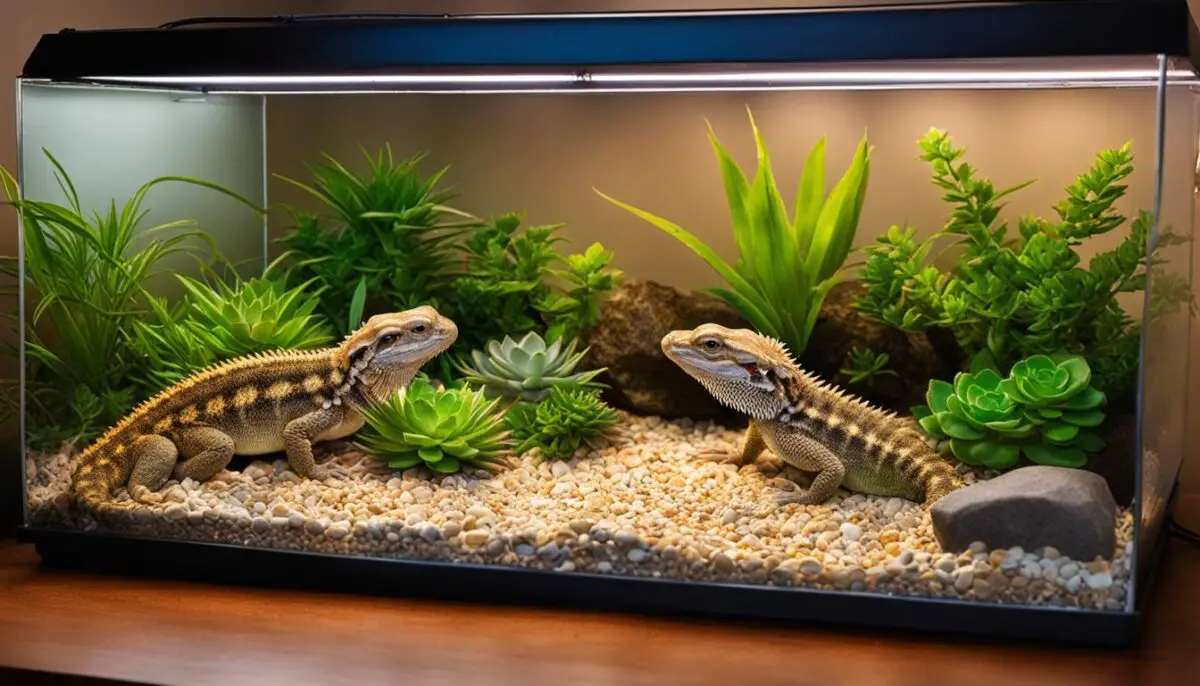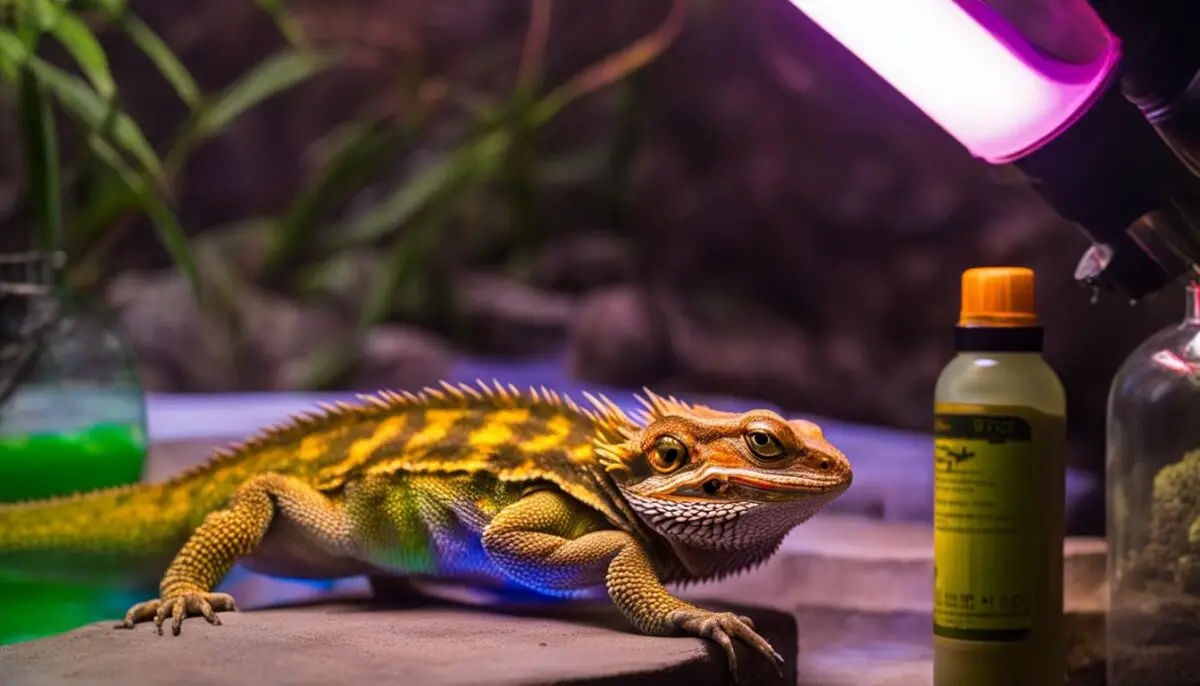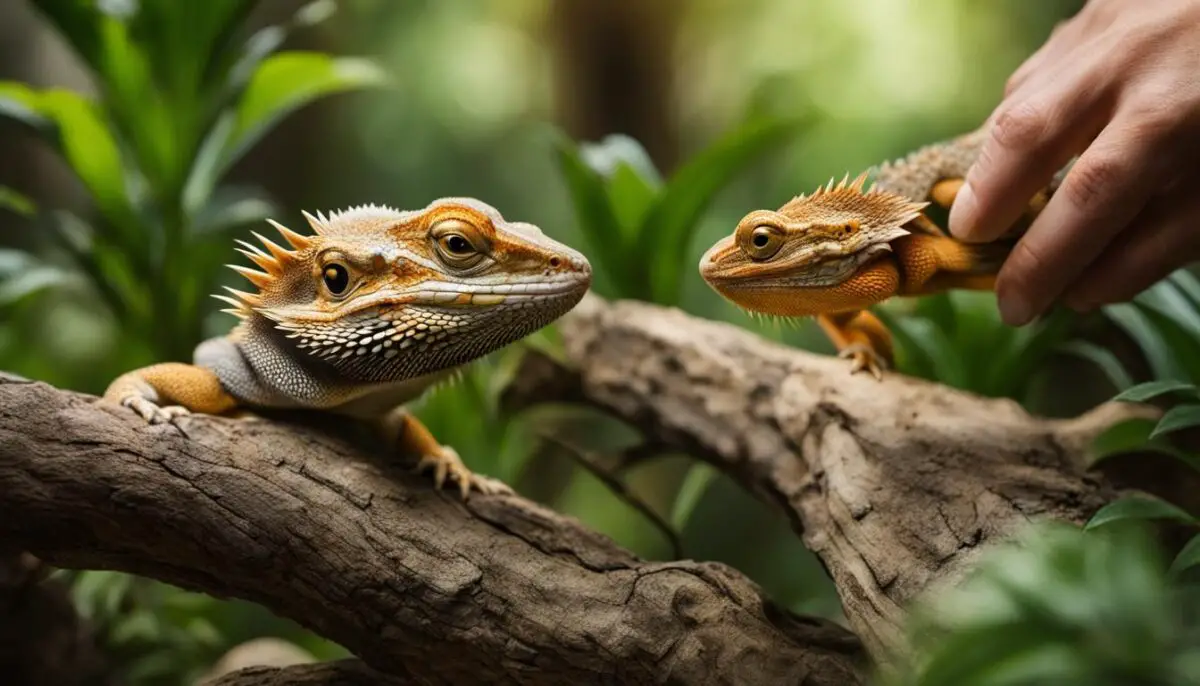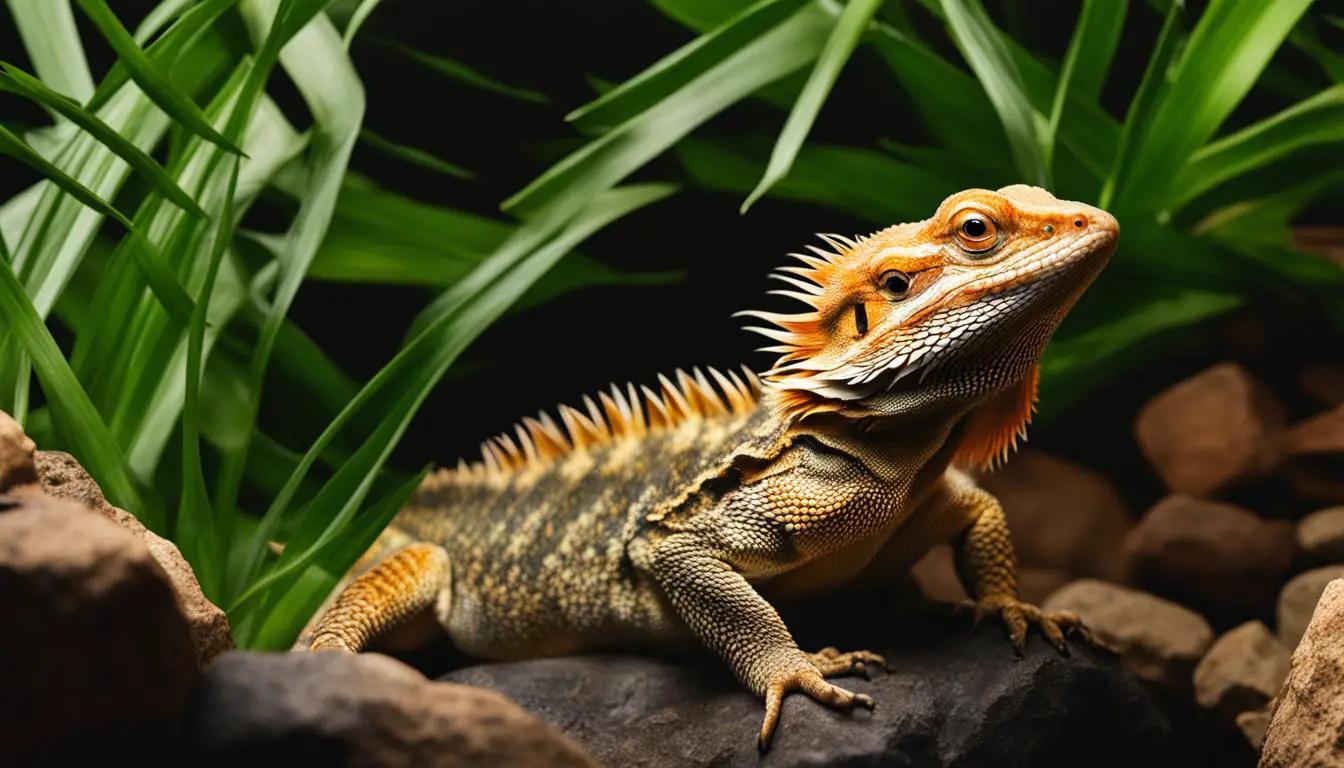Bearded dragons are intelligent, playful, and inquisitive reptiles that make popular pets. At 11 months old, these lizards have unique personalities and specific care requirements. In this complete care guide, you will learn everything you need to know about caring for your 11-month-old bearded dragon, including information on their size and growth.
- Bearded dragons at 11 months old have unique personalities and specific care needs.
- They continue to grow, with most of their growth occurring in the first year of their life.
- Proper habitat, nutrition, and lighting are crucial for their well-being.
- Maintaining optimal temperature and humidity levels is important for their health.
- Regular veterinary care and monitoring their behavior are essential for their overall wellness.
Bearded Dragon Size & Growth: How Big Do Bearded Dragons Get?
If you’re curious about the size of your 11-month-old bearded dragon and how big they can eventually grow, you’ve come to the right place. Bearded dragons can reach lengths of 18-24 inches from snout to tail as adults, with males generally being slightly larger than females. At 11 months old, your bearded dragon is still experiencing growth, with the majority of their growth occurring during the first year of their life. On average, they can reach a size of 16-22 inches by the time they reach 12 months old. However, it’s important to note that individual growth rates can vary.
Understanding the typical size of a bearded dragon can help you assess whether your pet is growing as expected. It’s also worth mentioning that the size of a bearded dragon can be influenced by various factors, including genetics, diet, and overall health. By providing proper care, including a suitable habitat and a balanced diet, you can help your bearded dragon reach their full growth potential.
To give you a visual representation of the typical size of a bearded dragon at various stages of life, here is a size chart:
| Age (Months) | Size (Inches) |
|---|---|
| 0-3 | 3-5 |
| 4-6 | 7-9 |
| 7-12 | 10-18 |
| Adult | 18-24 |
Keep in mind that this size chart is a general guideline and that individual bearded dragons may vary slightly in their growth. Regularly monitoring your bearded dragon’s size and overall health will help ensure they are thriving.
Bearded Dragon Care: Creating the Ideal Habitat
Creating the ideal habitat for your 11-month-old bearded dragon is crucial for their health and well-being. A well-designed enclosure will provide them with a comfortable and safe environment that mimics their natural habitat. Here are some important factors to consider when setting up their habitat:
Enclosure Size
The size of the enclosure is important to accommodate your growing bearded dragon. At this stage, a 20-gallon tank is suitable, but as they continue to grow, their tank should increase in size. Fully-grown adult bearded dragons typically require a 120-gallon tank to ensure they have enough space to move around and exhibit natural behaviors.
Lighting and Temperature
Bearded dragons rely on proper lighting and temperature gradients to maintain their health. Your bearded dragon’s tank should include a UVB light to provide them with the necessary UV rays for calcium absorption. A basking spot with a temperature of 95 to 105°F should be provided, along with a cooler area around 75°F for them to regulate their body temperature. Thermometers should be used to monitor these temperatures regularly.
Substrate and Decorations
Choosing the right substrate for your bearded dragon’s enclosure is essential. Reptile carpet or non-adhesive shelf liner are good options, as they are easy to clean and prevent the risk of impaction. Avoid loose substrates such as sand or gravel, as they can be ingested and cause health issues. Adding decorations such as rocks, branches, and hides will create a stimulating and enriching environment for your bearded dragon.
By providing the ideal habitat for your 11-month-old bearded dragon, you are ensuring their physical and mental well-being. Creating a comfortable and stimulating environment will promote their natural behaviors and allow them to thrive.
| Enclosure Size | Lighting and Temperature | Substrate and Decorations |
|---|---|---|
| A 20-gallon tank is suitable for an 11-month-old bearded dragon. | Provide UVB lighting for calcium absorption and a basking spot with a temperature of 95 to 105°F. | Choose a safe substrate like reptile carpet and add decorations for enrichment. |
| As they grow, fully-grown adults require a 120-gallon tank. | Use thermometers to monitor temperature gradients regularly. | Avoid loose substrates that can cause health issues. |

Feeding Your 11-Month-Old Bearded Dragon
Proper nutrition is essential for the health and well-being of your 11-month-old bearded dragon. At this age, they should have a balanced diet consisting of both protein and greens. As omnivores, they require a combination of animal and plant matter to meet their nutritional needs.
For protein, you can feed your bearded dragon small Dubia roaches or crickets. Aim for 20-40 insects per day, adjusting the quantity based on their appetite and size. These insects should be gut-loaded and dusted with calcium powder before feeding to ensure your dragon receives the necessary nutrients for healthy bone development.
In addition to protein, it’s important to provide your bearded dragon with a variety of vegetables. Collard greens, dandelions, and squash are excellent options that offer different vitamins and minerals. Offer a mixture of these vegetables daily, ensuring they are finely chopped or shredded for easier consumption. It’s important to avoid feeding your bearded dragon fruits, as they have high sugar content that can lead to health issues.
Bearded Dragon Feeding Schedule
Establishing a feeding schedule for your 11-month-old bearded dragon is important to maintain a healthy routine. Provide food in the morning and remove any uneaten portions after a few hours to prevent spoilage and bacterial growth. It’s important to monitor their appetite and adjust the quantity of food accordingly. Remember to always provide fresh, clean water in a shallow dish that is easily accessible to your bearded dragon.
| Protein | Vegetables |
|---|---|
| Dubia roaches | Collard greens |
| Crickets | Dandelions |
| Squash |
By providing a balanced diet and establishing a feeding schedule, you can ensure that your 11-month-old bearded dragon receives the necessary nutrients for optimal growth and overall health.
Maintaining Proper Lighting and Temperature
Proper lighting and temperature are essential for the health and well-being of your 11-month-old bearded dragon. These reptiles require specific lighting conditions to support their metabolic processes and maintain optimal bone health. Additionally, maintaining the right temperature gradient in their habitat is crucial for regulating their body temperature and providing comfortable basking spots.
Bearded Dragon Lighting
Bearded dragons require both UVA and UVB lighting to thrive. The UVB light stimulates the production of vitamin D3, which enables the absorption and metabolism of calcium in their bodies. This is crucial for preventing metabolic bone disease, a common health issue in reptiles. To provide adequate UVB lighting, use a fluorescent UVB light tube designed for reptiles. Place it within 12 inches of their basking area and replace the bulb every six to eight months to ensure optimal output.
Bearded Dragon Heating and Basking Temperature
Bearded dragons are ectothermic, meaning they rely on their environment to regulate their body temperature. It’s important to provide a temperature gradient within their habitat, with a basking spot that reaches a temperature of 95 to 105°F. This allows them to thermoregulate by moving between warmer and cooler areas as needed. Use a heat lamp or ceramic heat emitter to create the basking spot, and monitor the temperature using a thermometer placed at the basking spot level.
Table: Recommended Temperatures for Bearded Dragons
| Temperature | Location |
|---|---|
| 75°F to 85°F | Cool Side |
| 95°F to 105°F | Basking Spot |
With proper lighting and temperature, your 11-month-old bearded dragon will have the ideal conditions to thrive and maintain their health. Regularly monitor the temperature and lighting in their habitat to ensure they stay within the recommended ranges. Providing these essential elements will help support their overall well-being and ensure a happy and healthy life for your beloved pet.
Monitoring Humidity Levels in the Bearded Dragon Habitat
Maintaining appropriate humidity levels in the bearded dragon habitat is important for their overall health and well-being. Bearded dragons are native to arid regions, so it’s crucial to provide them with a habitat that replicates these conditions. The ideal humidity range for bearded dragons is 30% to 40%. This level of humidity is necessary to help them shed properly, stay hydrated, and prevent respiratory issues.
To monitor the humidity levels in your bearded dragon’s habitat, it’s recommended to invest in a hygrometer. A hygrometer is a device that measures humidity and helps you ensure that the levels are within the appropriate range. Place the hygrometer in a central location in the tank where it can accurately measure the humidity.
In addition to monitoring humidity, providing a shallow water dish in the tank is essential. Bearded dragons will drink from the dish and also use it to soak themselves, which aids in hydration and maintaining their natural moisture balance. The evaporation from the water dish will also contribute to the overall humidity level in the tank.

| Humidity Level | Recommended Actions |
|---|---|
| Below 30% | Add a larger water dish or mist the tank with water to increase humidity. |
| 30% to 40% | Humidity levels are within the ideal range. Maintain regular misting and ensure the water dish is clean and full. |
| Above 40% | Decrease humidity by improving ventilation, reducing misting, or using a dehumidifier if necessary. |
Remember that humidity levels can vary depending on the climate and the size of the tank. It’s important to monitor the levels regularly and make any necessary adjustments to keep your bearded dragon comfortable and healthy.
Sexing Your Bearded Dragon
Sexing your 11-month-old bearded dragon can be an exciting and informative experience. While the sexual differences may not be immediately noticeable, there are certain characteristics that can help you determine if your bearded dragon is male or female. By understanding these differences, you can gain a deeper insight into your pet’s biology and behavior.
The first characteristic to look for is the presence of bulges along the tail. Males typically have two elongated bulges along their tails, while females have only one bulge above the cloaca. This is due to the presence of hemipenes, the paired reproductive organs found in male bearded dragons.
Additionally, males tend to grow larger than females and have larger heads. While this difference may not be immediately noticeable at 11 months old, it becomes more pronounced as they continue to mature. By observing these physical characteristics, you can make an educated guess about the sex of your bearded dragon.

Health and Wellness of Your Bearded Dragon
Ensuring the health and wellness of your 11-month-old bearded dragon is essential for their overall wellbeing. These reptiles require proper care, nutrition, and regular veterinary check-ups to thrive. By being proactive and attentive to their needs, you can help prevent common health issues and provide a long and happy life for your pet.
One important aspect of bearded dragon health is their diet. Feeding your lizard a balanced mix of protein and greens is crucial. Be sure to offer a variety of insects, such as small Dubia roaches or crickets, along with nutritious vegetables like collard greens and squash. Dusting their food with calcium a few times a week helps support their bone health. Regularly monitoring their appetite and ensuring they receive the necessary nutrients is key.
Another essential factor in bearded dragon wellness is maintaining proper habitat conditions. Providing a suitable enclosure with the right temperature gradients, lighting, and humidity levels is crucial for their overall health. Be sure to monitor the temperature using thermometers and adjust as needed to create a comfortable environment. Additionally, maintaining appropriate humidity levels, between 30% to 40%, helps prevent dehydration and excessive moisture-related issues.
| Common Health Issues | Symptoms | Prevention |
|---|---|---|
| Metabolic Bone Disease | Fragile bones, swelling, lack of appetite | Proper calcium and UVB light supplementation, balanced diet |
| Respiratory Infections | Coughing, wheezing, mucus discharge | Clean and maintain a clean habitat, avoid temperature extremes |
| Abnormal Shedding | Stuck shed, retained skin, dry patches | Provide a humid hide, ensure proper hydration |
Regular visits to a reptile veterinarian are crucial for detecting and addressing any health concerns. Your veterinarian can provide guidance on routine check-ups, vaccinations, and parasite prevention. They can also offer advice on handling, behavior, and any other specific concerns you may have about your 11-month-old bearded dragon.
Conclusion
Caring for an 11-month-old bearded dragon involves providing the ideal habitat, proper nutrition, and maintaining optimal lighting and temperature. By creating a suitable environment with the right tank size, lighting, and temperature gradients, you can ensure the well-being of your bearded dragon. Remember to offer a balanced diet consisting of protein and greens, supplemented with calcium for their bone health.
Regular monitoring of humidity levels, sexing your bearded dragon, and gentle handling are crucial for their overall health and socialization. Additionally, keeping an eye out for common health issues and seeking veterinary care when necessary will help ensure that your bearded dragon lives a long and happy life.
By following this complete care guide, you can provide the best possible care for your 11-month-old bearded dragon. Whether you’re a first-time owner or an experienced reptile enthusiast, your commitment to their care will strengthen the bond between you and your scaly friend. Remember, responsible care and attention are key to fostering a fulfilling and rewarding pet-owner relationship.
FAQ
How big do bearded dragons get at 11 months old?
At 11 months old, bearded dragons can grow to be between 16-22 inches long from snout to tail.
What size tank does an 11-month-old bearded dragon need?
At 11 months old, a bearded dragon still requires a 20-gallon tank, but as they continue to grow, their tank size should increase. Fully-grown adults typically need a 120-gallon tank.
What should I feed my 11-month-old bearded dragon?
An 11-month-old bearded dragon’s diet should consist of a balance of protein and greens. You can feed them small Dubia roaches or crickets for protein, along with vegetables such as collard greens, dandelions, and squash.
What lighting and temperature should I provide for my 11-month-old bearded dragon?
Your 11-month-old bearded dragon requires 12 hours of light each day, provided by a UVB light tube and a UVA bulb. The basking temperature should be between 95 to 105°F, with the cold side of the tank around 75°F.
How do I maintain the humidity levels in my bearded dragon’s habitat?
The humidity in the bearded dragon habitat should be kept between 30% to 40%. Including a shallow water dish in their tank allows for natural evaporation. Using a hygrometer can help you accurately measure the humidity levels.
How can I determine the sex of my bearded dragon?
Males typically have two elongated bulges along their tails and more prominent femoral pores, while females have only one bulge above the cloaca. Males also tend to grow larger than females and have larger heads.
How should I handle and socialize my 11-month-old bearded dragon?
It’s recommended to wait at least a week after bringing your bearded dragon home before attempting to handle them. When handling, make sure to support their belly and be gentle. Daily handling can help them become more comfortable with human interaction.
What health issues should I watch out for in my bearded dragon?
Common health issues in bearded dragons include metabolic bone disease, respiratory infections, and abnormal shedding. Regular visits to a reptile veterinarian can help prevent and address any health concerns.


